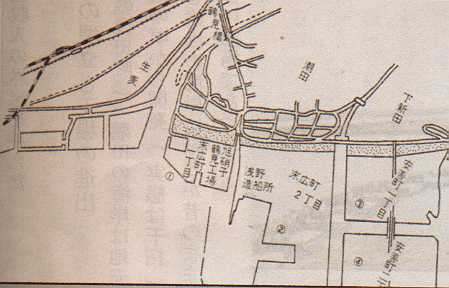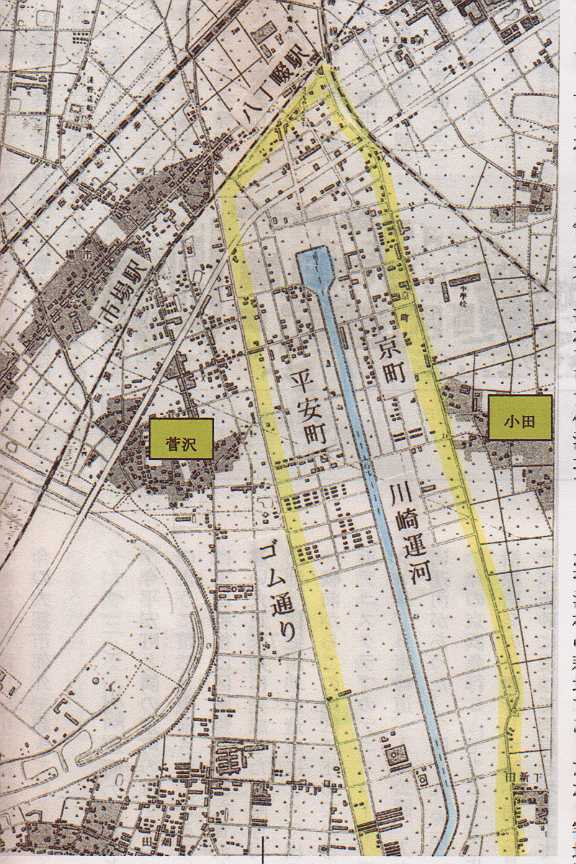- Yokohama-shi Top Page
- Tsurumi Ward Top Page
- Introduction of the ward
- Overview of Tsurumi Ward
- History of Tsurumi Ward
- 13th: Koshi Sugasawacho (Part 3)
Here's the text.
13th: Koshi Sugasawacho (Part 3)
Last Updated July 9, 2024
Reclaiming shores and entering factories
The opening of the railway
Yoshinobu Tokugawa, the last shogun in 1868 (the first year of Meiji), collapsed here in response to the reign of the great government, when a new Meiji government was established and lasted for about two and a half centuries. Prior to the Meiji Restoration, in 1860 (the first year of Mannobu), Yokohama opened the port, and the long-term isolation has ended, modernized, and the wave of internationalization has rushed to Sugasawa Village.
The Meiji government started construction of railways between Shimbashi and Yokohama in 1870, opened between Shinagawa and Yokohama on May 7, 1872, and started temporary business on September 12, Shimbashi and Yokohama, and opened Tsurumi Station. People along the railway line were surprised to see with curiosity the British land vapor running powerfully with black smoke. With the opening of the railway, the Tokaido, which was a major departure in the Edo era, was deserted, and Kawasaki-juku and other places disappeared as lodgings due to the disappearance of the horse-training system. On the other hand, Yokohamamura, which was a cold village, became the most vibrant town in Japan for raw silk exports, with foreign trading companies lined up with the opening of the port.
Sugasawa Village, which was a pure rural village, was not directly related to these events, but some houses made Western vegetables, fruits (pears, peaches), etc., and benefited from cash income in this region, which had nothing to sell other than rice Was.
Landfill by Soichiro Asano
The coasts of Oda, Shimoshinden (now Asano-cho), and Shiota have already been developed (reclamated) by local influential people since the end of the Tokugawa period. However, most shallow shores were still good fishing grounds for fish, shellfish, seaweeds, etc.
Businessman Soichiro Asano visited Europe and the United States in 1896, and learned that huge industrial areas were concentrated on coastal landfills. After returning to Japan, he conducted a field survey of the coast between Kanagawa and Tokyo, and determined that the coast off Oda and Shiota was the ideal suitable area, and started landfill work in 1912 in collaboration with Zenjiro Yasuda, the financial community. There were many twists and turns, but in 1913, U.K. purchased a state-of-the-art electric sand pump ship and started full-scale landfill work, completed in 1922. In this area, leading companies such as Asahi Glass, Asano Cement, Nippon Kokan Works, Asano Shipbuilding Works, Nippon Kokan Tsurumi Shipyard, Shibaura Works (now Toshiba), Standard Oil, Rising Sun Oil and Mitsui Oil Co., Ltd. entered the area and became the core of the Keihin Industrial Zone.
On the other hand, people in this area, such as Sugasawa, who were farmers, engaged in the construction of these factories while farming, and earned cash income that could not be obtained from agriculture. According to the people of Sugasawa who went to work at the construction site of Shibaura Works, the factory was the state-of-the-art factory in the East at the time, modeled on GE in the United States. At that time, there were few construction companies in Japan that built such factories, and U.S. construction companies contracted, and many American engineers and field supervisors came. My father's friend was only elementary school, but while working under the direction of an American, he learned English, gained the reputation of an American director, became an interpreter and director, and on a day off, an American director came to Sugasawa's house to play.
When a factory is built, the people who work there are naturally needed. Many people in this area have stopped farming or started working as a part-time farmer now. It seems to be nothing now, but since the Edo period, small farmers who have been wearing poor clothes all year round and crawling through fields and fields, and have been struggling to work hard, but have not been able to eat their own rice. For the farmers, working at a factory and paying a salary was a huge event and a great change. In addition, related people such as those working at factories, subcontractors, and contractors who enter and exit the purchase of goods from all over the country gathered, especially in the Shiota area near the factory, construction of houses progressed, and shopping streets were booming . Sugasawa, which is adjacent to Shiota, gradually buried rice fields, houses were built, shopping streets were created, and changed from rural areas to urban areas. A large peasant with a large land gradually stops the peasant, rents it as residential land or builds a rental house, and becomes an asset house. It is the same as the current phenomenon occurring in the suburbs of large cities (see Figure 8).
Excavation of rivers and canals and birth of Kyomachi and Heian-cho
The roads of Heian-cho and the neighboring town of Kyo-cho are now neatly maintained like a grid. This was actually made by the excavation of the Kawasaki Canal, which was completed at the end of Taisho, and the construction of factory and residential land.
People who have lived in the area before the war have known, but now there are canals on the tennis courts of the Keihin Tennis Club, as well as on the north and south sides of the condominium, Nitto Ryokudo, Irifune Park and Irifune Bridge south. As part of the development of the railway line by Keihin Electric Railway (Keikyu), the canal was opened at the border between Oda and Sugasawa from 8 to 2011, and the earth and sand was reclaimed on both banks to create an industrial land of 250,000 tsubo. Factories such as Yokohama Rubber and Kyosan Electric Mfg. have entered the market, but due to the economic recession at that time, it is unlikely that the factory site will be sold out, and the rest will be used as residential land, and roads will be maintained and sold. It is the cityscape of Kyomachi.
Along with the completion of land reclamation off Oda and Shiota, and the construction of large factories one after another, Sugasawa lost the main part of cultivated land, transforming from a rural area to a city (also called a residential area) at once. I went. At that time, the acquisition price ranged from 1.30 yen to 1.50 yen per tsubo, and Keihin Electric Railway recorded 390,000 yen for the acquisition cost of 300,000 tsubo (including Kyomachi). There were some friends from Heian-cho in the class at Heian Elementary School where I attended. I've been to their homes, the children of those who bought early subdivisions, but the mansion is a stylish Western-style house with about 100 tsubo, with farm-style houses and tenement houses around Sugasawa. The atmosphere was different from the scenery.
Many of the residents came from Tokyo, and in the early days there were many socially high-level people such as famous Kabuki actors, painters, and white collars of large companies. Now, it's a subdivision along the Denentoshi Line. However, these people gradually left due to the smoke of the factory and the deterioration of the surrounding environment. In the early days, this canal was used by boats, but it was not used much as a canal, and since around 1941 it was reclaimed and disappeared by the slag of Nippon Kokan (see Figure 9).
From the village to the town
Sugasawacho is currently in Sugasawa-cho, Tsurumi-ku, Yokohama-shi in terms of administrative divisions, but Sugasawacho has become the present after several changes as it has history and changes in every town.
◆Edo period → 1868 / Sugasawa-mura, Tachibana-gun, Musashi-kuni
The name of Sugasawa Village has existed since the early Edo period.
◆Meiji 1st year-end March 2010 / Sugasawa-mura, Tachibana-gun, Kanagawa Prefecture
The Meiji Restoration changed the region from Musashi country to Kanagawa prefecture.
◆April 1, 1889 → March 31, 1923/Tamura, Tachibana, Kooricho, Kanagawa Prefecture
With the enactment of the municipal system, the Meiji government merged several villages, and Egasaki Village, Yamu Village, Market Village, Sugasawa Village, Shiota Village, and Ono Nitta became Machida Village. This will be the stepping stone that Sugasawa Village and others will later be transferred to Yokohama City. In addition, each village, including Sugasawa Village, becomes the capital of Machida Village.
◆April 1, 1923 → March 31, 1925 / Shiotamachi, Tachibana-gun, Kanagawa Prefecture
The town system was established and renamed Shiotamachi, and each village has a large name of the old village.
At the time of the Great Kanto Earthquake, it was Shiotamachi.
◆April 1, 1925 → March 31, 1927 / Tsurumicho, Tachibana-gun, Kanagawa Prefecture
Shiotamachi and Tsurumicho judged that it would be better to merge for various reasons, and merged with Tsurumicho.
It's a coincidence. In particular, we will jointly promote measures against flood damage in the Tsurumi River and respond to water supply and reconstruction project plans for the Great East Japan Earthquake.
We decided to make further efforts.
◆April 1, 1927 / Sugazawa-machi, Tsurumi-ku, Yokohama-shi, Kanagawa Prefecture
Transferred to Yokohama City, implemented ward administration on October 1, the same year, and continues to this day.
It was transferred to Yokohama City, and then the ward system was established and became the current name. This is because Yokohama City, which has been developing since the opening of the port, needed a coastal area of Tsurumi to further expand the port, and a flat land behind the coastal area of Tsurumi to develop as an industrial city It is said that it was necessary. There was opposition to the merger with Yokohama City, but it was realized after many twists and turns. At the time of this transfer, Tsurumi said that it would be more advantageous to go to Yokohama City than to carry out a hugely expensive water supply business alone.
As a result of this transfer, Shiota, Sugasawa, Market, Egasaki, and Yako on the left bank of the Tsurumi River, which had been Kawasaki since the Edo period, were originally in Kawasaki City, but became Yokohama City.
The name and nickname used in Sugasawacho (village)
Before the war, local people often called each other's house by their trade name. A nickname may be more appropriate than a shop name. In the past, the whole village was a peasant and a community of village fate, so it seems that it was named with a familiarity and nickname. At present, only the retired house is used as a well-known name, but few others are used. It seems to be destined to be forgotten and disappear. I would like to introduce some of them.
East (house), West (house), South (house), North (house), Retiring, Raoya, Teramae (in front of the temple, Teramae), Hebei Don
Chodosan Muke-'s house (opposite house), Nittsuyama, Ikushinya, shop, edge (no house), Hachiemu-san
(Mr. Hachiemon), Mr. Konjo, Mr. Dendo, Mr. Copperkin
※The name of the house, nicknamed "House" is read as "Uchi".

Figure 8: Landfill in Industrial Zones, History of Tsurumi Ward

Figure 9: Subdivisions in Kawasaki Canal, Kyomachi and Heian-cho
Inquiries to this page
Tsurumi Ward General Affairs Department Ward Administration Promotion Division
Telephone: 045-510-1680
Telephone: 045-510-1680
Fax: 045-510-1891
Email address: tr-kusei@city.yokohama.lg.jp
Page ID: 333-533-991













